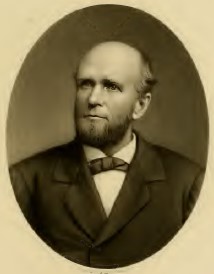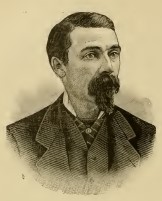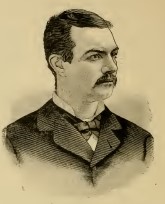|
L. W. LEE ----Is a native of New York, having
been born in Genesee County in 1834. When he was quite young
he removed with his parents to Elkhorn, Walworth County,
Wisconsin, and they were among the first settlers of that
section of the country. In 1860 Mr. Lee crossed the
plains, and located at Gold Hill, Storey County, Nevada, where
he remained for about five years, part of the time engaged in
keeping hotel, he afterwards went to Long Valley and engaged
in ranching and keeping station until 1873, at which time he
came to Reno, where he has since resided.
Mr. Lee is the
owner and proprietor of the well-known livery and feed stable,
situated on the southwest corner of Fourth and Sierra Streets.
The building is 69x100 feet, two stories, first of stone and
second of brick, and was built by him in 1875. In connection
with his livery business he is quite extensively engaged in
shipping cattle, often ships as high as 8,000 head in a single
year, about one-half of them being weighed at Reno. He was
married in December, 1858, at Elkhorn, Wisconsin, to Miss
Julia D. Moore, a native of that
place.
 B. F. LEETE ----is one of the many thousands sent
out by the pioneer States in the Railroad and Canal
developments, which have resulted in such an unprecedented
growth of a nation in wealth and power. Little did Clinton
think what a movement he was inaugurating when he projected
the Erie Canal.
Although his ideas were far in advance of the age, his
wildest dreams fell far short of the reality. When " Clinton's Ditch " was
completed to the central and western parts of New York,
opening up a market for the wheat, the State took a start in
the race for wealth which it has maintained to the present
day. It was the awakening of that spirit of enterprise that
has since girdled the world with electric wires and
reticulated a continent with railroads; that has sent into the
commercial arteries of the world a set of business men whose
ideas of development and extension of business enterprises
found no geographical limits, no obstructions in lofty
mountain ranges, deserts, or wide oceans. Fifty years since
almost every daring enterprise was projected by a New Yorker.
Men from, their infancy were accustomed to consider great
enterprises, and railroads, canals, and lines of steamers were
planned by school children as pastimes. B. F. LEETE ----is one of the many thousands sent
out by the pioneer States in the Railroad and Canal
developments, which have resulted in such an unprecedented
growth of a nation in wealth and power. Little did Clinton
think what a movement he was inaugurating when he projected
the Erie Canal.
Although his ideas were far in advance of the age, his
wildest dreams fell far short of the reality. When " Clinton's Ditch " was
completed to the central and western parts of New York,
opening up a market for the wheat, the State took a start in
the race for wealth which it has maintained to the present
day. It was the awakening of that spirit of enterprise that
has since girdled the world with electric wires and
reticulated a continent with railroads; that has sent into the
commercial arteries of the world a set of business men whose
ideas of development and extension of business enterprises
found no geographical limits, no obstructions in lofty
mountain ranges, deserts, or wide oceans. Fifty years since
almost every daring enterprise was projected by a New Yorker.
Men from, their infancy were accustomed to consider great
enterprises, and railroads, canals, and lines of steamers were
planned by school children as pastimes.
The subject of this sketch was the outgrowth,
the logical sequence, of that unprecedented intellectual
activity that gave birth to such men of enterprise and courage
as those who projected and completed the trans-continental
railroads, and who outstrip the fables of the Arabians in
their development of mechanical powers. B. F. Leete was born
at De Ruyter, Madison County, New York, February 25,
1831. He had the
advantages of the common schools, and also of the Union School
of Lockport, in his native State.
It will be remembered by our readers that
Lockport is the site of the connection of the Tonawanda Creek
with the long levels of the Erie Canal, involving an elevation
of the boats by means of locks of about eighty feet. The
works, though surpassed by many engineering projects since,
were, at the time, considered stupendous, and undoubtedly the
vast piles of cut granite, forming the five different lifts,
had a stimulating influence in determining him to adopt the
profession of civil engineering. At the age of twenty we find
him engaged in the construction of the Niagara Branch of the
New York Central Railroad. This was completed and opened to
the public in September, 1852.
He was next engaged in the exploration and
location of a route for branches of the New York and Erie
Railroad, under the immediate direction of Alfred Tufts, of
Boston, and S. W.
Hall, of Philadelphia. These explorations were completed early
in 1854, from which time he engaged in bridge-building until
1858. When the trans-continental railroad was projected he was
employed with the famous engineer. T. D. Judah, to make the
preliminary surveys from Sacramento eastward, the road being
afterwards located nearly on the same survey. After the
Central Pacific was well under way, he took charge of the
Swamp Land Surveying Corps, for Sacramento District, during
the years 1861-62. In the fall of 1862 he bridged the Pajero
River below Gilroy, on the line of Santa Clara and Monterey
Counties, for T. P. Sargent and Brothers.
In September, 1863, he surveyed, and in company
with F. Birdsall, built the Golden Canon Grade. This operation engaged
his attention until 1869, when he discovered the great salt
mine in Churchill County. Perceiving the value of these in
connection with the immense reduction of silver on the
Comstock and other mines, he built the Eagle Salt Works, from
which are supplied all the mines of the Comstock. Previous to this salt
was imported from the coast, or brought long distances from
the interior, in some instances on the backs of Indians, These
works being on the line of the Central Pacific Railroad, he
was enabled to supply the mills at a much lower figure than
they were formerly accustomed to pay.
In consequence of the
permanent character of his Nevada investments, he removed his
family to Reno, where he has, since 1871, resided with his
family when not absent on some of his numerous business
operations. His residence, a view of which is given in this
work, indicates taste and a love of beauty without a desire
for ostentatious display. Visitors will find the interior
corresponding with the exterior in its arrangements for
comfort and the gratification of the high
aspirations of cultivated minds.
A. A. LONGLEY -------Is a native of Kentucky,
born in Caldwell County, A. D. 1834. Receiving an education in
his native State he left there at the early age of nineteen
years, and came to California, where he was, for a number of
years, engaged in teaming and trading through the mountains.
In 1861 he came to the then Territory of Nevada,
and the next year thereafter settled on the place where he now
resides. At that time there were very few settlers in the
valley, the Indians predominating by a large majority. The
land had not been surveyed by the Government at that time.
Mr. Longley pre-empted 160 acres, and since then
has purchased about 500 acres more, and therefore has quite an
extensive ranch. By his persistent efforts, and indomitable
will and energy, he has produced from the originally barren
waste of sage-brush a beautiful, well-appointed ranch. The
expense of clearing the land of its rocks and sagebrush, and
the construction of ditches to convey the water of the river
over his land, has necessarily been great, but a glance around
his home-place shows what can be done in that line.
He is at the present time a successful
stock-raiser, and has experienced the ups and downs pertaining
to an early settlement in a wild and barren country. His
residence is on the Truckee Meadows, near Reno, in Washoe
County. He was married in 1866 to Miss Mary F. Moore, a native of
California, who died in May, 1877, leaving four children. In
June, 1879, he was married again, to Mrs. Mary O. Noyes, who
is a native of Massachusetts.
 R S. OSBURN -----the subject of the following
sketch, is a native of the State of Pennsylvania, having been
born at Meadville, Crawford County, on the twenty-first of
September, 1849. R S. OSBURN -----the subject of the following
sketch, is a native of the State of Pennsylvania, having been
born at Meadville, Crawford County, on the twenty-first of
September, 1849.
His education,
which was a liberal one, was received in his native town, and
when about seventeen years of age he left his home and settled
in Eugene City, Oregon, and engaged in the drug business. He remained at that
place until 1872, when he removed to Jacksonville, in the same
State, still continuing in the same business. After eighteen
months' stay in the latter place he came to Reno and formed a
partnership with J. E. Simpson, in the apothecary and drug
business, and since the death of his partner, in 1878, has
been associated in business with J. S.
Shoemaker.
Mr. Osburn was elected
County Clerk of Washoe County, on the Democratic ticket, in
1880. He was married in 1872 to Miss Anna E. Lemmon, of
Reno.
ANDREW SAUER, ---The subject of the
following sketch, is a native of Germany. He was born in the
village of Dielheim, on the fourteenth of January, 1829. In
the year 1850 he left the land of his birth, and emigrated to
the United States, locating first at Cincinnati, Ohio, where
he lived three years.
At the end of which period he came to the
Pacific Coast, and spent the succeeding six years, partly in
the mines, and the remainder in the butchering business, which
he successfully followed in Amador, Sacramento, and El Dorado
Counties.
Mr. Sauer is a shrewd business man; one
that is bound to succeed wherever his lot may be cast. A
desire to see more of his adopted country led him to Nevada,
as one of the early pioneers, in the year 1859, and located in
Washoe Valley, where he has since resided. He was married June
21, 1859, to Miss Catharine Baker, and is blessed with nine
living children at the present time, four boys and five
girls.
GEORGE SMITH, SR.
----The gentleman referred to in this short sketch is a native
of England, and was born at Sherrington, in 1816. In the year
1854 he crossed the ocean and found a home in the United
States, locating first at south Salt Lake City, Utah. After a
few years he, with his family, came to Carson Valley, Nevada,
and soon after located in a beautiful valley, which he very
appropriately named Pleasant Valley, lying further to the
north, towards the noted Steamboat Springs.
He now resides upon the
same ranch that he located in 1858. Mr. Smith was one of the
first, if not the first white man to settle along the eastern
base of the Sierra Nevada Mountains; and, by indomitable will
and great energy, has accomplished what very few men could
have done. The danger surrounding such an early settlement
among the Indians cannot be fully portrayed. He has a
well-stocked ranch, his business Iies in that direction, which
he fully understands. He has a large family, consisting of
eight children, all living, and an estimable
wife.
GEORGE S. SMITH
----The subject of this sketch is of English parentage, being
born in England, in the year 1840. At the early age of
fourteen years he came to the United States with his parents,
and lived with them at Salt Lake City, Utah, in the
neighborhood of five years, when they moved to the western
portion of the then Territory of Utah, and settled near his
present location, in Pleasant Valley, Washoe County.
Being an energetic and
capable young man, he soon distinguished himself among the
pioneers of those days, and stands well in the estimation of
his neighbors and acquaintances. He has a fine farm,
containing 160 acres, adjoining that of his father. He was
married in the year 1862, to Miss Ellen Cook, who is a native
of Scotland, their union being blessed with four children,
three of whom are living at the present time, death having
broken their family circle by taking their oldest child, a
son. Mr. Smith is pleasantly situated in his present location,
and is a gentleman respected by all who know
him.
JAMES SULLIVAN
-----Is a native of Ireland, and was born on the first of
February, 1836. At the age of twenty years he crossed the
water to America, and immediately after landing went to Port
Jervis, Orange County, New York, where he had relatives
living, where he remained until 1860, when he came to
California by way of the Isthmus of Panama, arriving in San
Francisco on the twenty-fourth of September. One month later
he went to Sacramento, and was employed in the hardware
establishment of Gillig, Mott & Co., during the next two
years.
In 1862 he came to
Nevada on business connected with the firm, and being
favorably impressed with the country, decided to locate here,
which he did in the month of March, 1863. in Truckee Meadows,
three miles northeast of Reno, on the Surprise Valley Road,
where he now resides. In 1864 he was in partnership with P.
J. Kelley in the
hotel business at Glendale, and during the same year built a
hotel on the Peavine Road, but soon after he withdrew from the
partnership a heavy snow and rain-storm having destroyed the
well, which had been dug at great expense, thereby rendering
the property valueless.
In 1872 Mr. Sullivan
built a fine brick house on the site of his first residence.
His ranch consists of 140 acres of very productive land, also
100 acres of grazing land, all of which is fenced and well
watered by irrigating ditches on over part of the ranch, which
is also well stocked with cattle. Through his indomitable will
and energy he has made a beautiful place out of a waste of
sage-brush, for which he deserves great
credit.
JOHN TWADDLE -----Was one of the pioneers of
Nevada. He was a native of Scotland, and was born on the
twentieth of July, 1825, near the city of Edinburgh. In 1848
he came to the United States, and located near St. Louis,
Missouri, where for five years he was engaged in mining.
In
the year 1853 he crossed the plains to Salt Lake City, Utah,
where he resided seven years, at which time he removed to the
western part of the Territory, now called Nevada, and located
in Washoe Valley. In company with his brother they decided to
make this their future home. Their claim was near where the
little town of Franktown now stands. The brothers lived
together for nine years, when the subject of our sketch sold
out to his brother, and located further down the valley, where
he lived until the date of his death, November 15, 1879. He
was married March 6, 1846, to Miss Jane Brown, who, with their
three children, still occupy the old home.
 W
A. WALKER ----was born in Charleston, Kanawha County,
Virginia, November 30, 1851. He received a thorough education,
being a graduate of Hanover College, at Hanover, Indiana, and
Notre Dame University, at South Bend, Indiana. He also spent
two years at the German Universities and in traveling through
Europe. In 1871 he came to the Pacific Coast and located in
the city of San Francisco, where he read law, intending to
adopt that profession. In 1872 became to Reno, Washoe County,
Nevada, and engaged in the mercantile business until 1878, at
which time he was elected Sheriff of the County, on the
Democratic ticket, and in 1880 was re-elected. Mr. Walker was married in
1874 to Miss Helen K. Fonda, of San
Francisco. W
A. WALKER ----was born in Charleston, Kanawha County,
Virginia, November 30, 1851. He received a thorough education,
being a graduate of Hanover College, at Hanover, Indiana, and
Notre Dame University, at South Bend, Indiana. He also spent
two years at the German Universities and in traveling through
Europe. In 1871 he came to the Pacific Coast and located in
the city of San Francisco, where he read law, intending to
adopt that profession. In 1872 became to Reno, Washoe County,
Nevada, and engaged in the mercantile business until 1878, at
which time he was elected Sheriff of the County, on the
Democratic ticket, and in 1880 was re-elected. Mr. Walker was married in
1874 to Miss Helen K. Fonda, of San
Francisco.
The information on Trails to the Past
© Copyright
may be used in personal family history research, with
source citation. The pages in entirety may not be
duplicated for publication in any fashion without the
permission of the owner. Commercial use of any material
on this site is not permitted. Please respect the
wishes of those who have contributed their time and
efforts to make this free site possible.~Thank you!
|